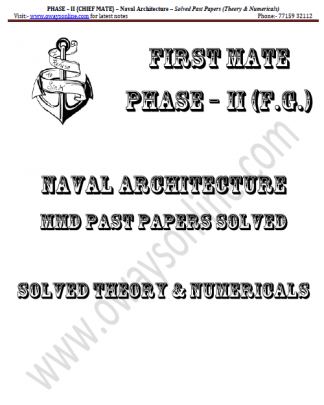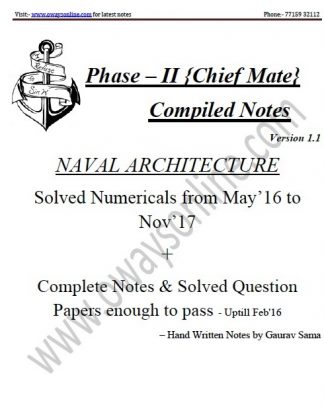Difference between the Synchronous Rolling & Parametric Rolling of ships:
Synchronous Rolling:-
- Every vessel has a natural rolling period which is inversely proportional to the square root of the GM and directly proportional to the beam of the ship.
- Synchronous rolling is caused when the rolling period becomes ‘synchronous’ with the period of wave encounter. When this occurs, the ship will heel over and in exceptional circumstances be rolled further over by the action of the wave.
- If the vessel encounters a series of swell in such a manner that the wave period matches the natural rolling period, the vessel will have no time righting itself before the next wave strikes. This situation if not corrected, can result in capsizing of the ship.
- The vessel encountering synchronous rolling is in a serious danger that she may heel over beyond a point from which it cannot return to the upright condition. She may end up with negative stability & eventually capsize.
- Synchronous rolling can be experienced regardless of the direction of sea w.r.t. the ship’s heading. But it is most likely to happen when natural rolling period of the ship is short or when sailing in high beam or quartering seas.
- Other danger associated with it is that of cargo shifting that can result in loss of stability and capsizing. Also, cargo lashings may give way because of the excessive rolling and cause damage to the cargo and in some cases, structural damage to the ship.
- A vessel which has suffered engine failure is most vulnerable to synchronized rolling and efforts to bring the vessel’s head into the wind should be made while she still has headway.
- To reduce synchronous rolling, following actions are suggested:
- Use ballast changes to alter KG and so the GMT of the vessel. By doing so, the rolling period will change making it of a non-synchronous value.
- Change the course of the ship so as to effectively change the period of wave encounter and eliminate the condition.
- Alter the speed of the ship until the synchronous rolling ceases to exist.
- It is imperative that the OOW recognizes the condition of synchronization immediately and immediately alters course to change the period of wave encounter and eliminates the condition.
Parametric Rolling:-
- Parametric rolling occurs when the pitching period is either equal to or half of that of the rolling period. Large roll angles may occur quickly in head or stern seas or nearly head or stern seas. The roll angle may increase from a few degrees to over 30 degrees in only a few cycles.
- It is caused due to the combination of various factors such as low initial stability, large flare around the water line, waves as long as ship’s length, sufficiently large wave amplitudes, period of encounter half the rolling period and low hydrodynamic roll damping.
- Parametric rolling is produced by the pitching motion on vessels which have a very fine bow together with very wide and flat stern like large container ships which have a large flare forward and a flat after ship.
- Parametric rolling is more when a ship is operating in heavy sea condition. Such conditions can generate extremely high loads on the lashings and containers. It can even exceed the breaking load of the container lashings. As a result, the cargo & vessel could be damaged & containers could be lost.
- Parametric rolling causes heavy stresses in the ship’s structure especially fore and aft parts. It also causes variation in the load of ship’s main engines. If not tackled quickly, it can also result in the capsizing of the vessel.
- As the stern dips into the waves, it produces a rolling action. The rolling action is different at the stern than to those at the bow which causes a twisting along the ship leading to the extra rolling motion.
- IMO suggests that parametric rolling is dangerous when the wavelength is one to 1.5 times the ship’s length.
- Ships which have a high GM will have a shorter roll period and unlikely to have parametric rolling in head/stern seas. Ships which have a low GM will have a long rolling period and are likely to have parametric rolling in head/stern seas.
- To reduce parametric rolling, following actions are suggested:
- Use ballast changes to alter KG and so the GMT of the vessel. By doing so, the rolling period will change making it of a non-synchronous value.
- Anti-rolling stability tanks to be provided to transfer water across the ship. A quick response time is vital to counteract this rolling.
- Hydraulic fin stabilizers would help to reduce parametric rolling.
- Slow down and alter to a more favourable course to ease vessel’s motion by breaking resonance between rolling period & wave encounter period.

